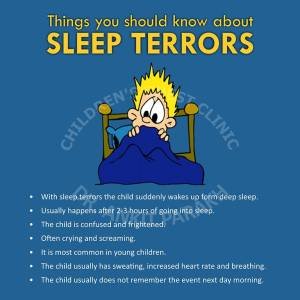
Parasomnias in Children: Understanding Sleep Walking, Sleep Terrors, and Confusional Arousals
What is Sleep Walking?
Sleep walking, also known as somnambulism, typically occurs during deep non-REM sleep, usually in the first third of the night. A child may sit up, walk around, or even perform complex activities while still asleep. They often have no memory of the event upon waking.
Key features of sleep walking:
- Occurs during the deepest stages of non-REM sleep.
- Episodes can last a few seconds to several minutes.
- Affected children may appear confused or disoriented if awakened.
Triggers include:
- Sleep deprivation.
- Stress or anxiety.
- Fever or illness.
- An irregular sleep schedule.
Understanding Sleep Terrors
Sleep terrors, also known as night terrors, are intense episodes of fear that occur during non-REM sleep. Unlike nightmares, which occur during REM sleep, children experiencing sleep terrors are not fully awake and may scream, cry, terrified or thrash around.
Characteristics of sleep terrors:
- Occur in the first few hours of sleep.
- The child is inconsolable and may not recognize caregivers.
- Typically, the behaviours are non-injurious but can cause significant concern to parents.
- Episodes typically last 5–20 minutes and resolve spontaneously.
Triggers include:
- Fatigue or inadequate sleep.
- Stressful life events.
- Fever or other illnesses.
What Are Confusional Arousals?
Confusional arousals are another type of parasomnia that occurs when a child is partially awakened from deep sleep also known as sleep drunkenness. During these episodes, a child may sit up in bed, look around, or mumble incoherently, often appearing confused.
- Disorientation and sluggish movements.
- Does not respond to commands from parents during the episode.
- The child usually does not recollect the event the next day morning.
Managing Parasomnias in Children
Although parasomnias are usually benign and tend to resolve as children grow older, they can be concerning for parents. Here are some strategies to manage them:
- Maintain a Regular Sleep Schedule: Consistent sleep patterns can reduce the likelihood of parasomnias.
- Ensure Adequate Sleep: Sleep deprivation is a common trigger.
- Create a Safe Sleep Environment: Remove sharp objects and lock doors or windows to prevent injuries during sleep walking.
- Avoid Stress and Anxiety: Relaxation techniques or counselling may help reduce triggers.
- Consult a Specialist: If episodes are frequent, prolonged, or cause significant disruption, seek advice from a pediatric sleep specialist.
Parasomnias, such as sleep walking, sleep terrors, and confusional arousals, can be challenging for families. However, with proper understanding and management, most children outgrow these conditions without long-term consequences. For persistent issues, consulting a pediatric sleep specialist can provide effective solutions and peace of mind.
Conclusion
Sleep Disorders in children
Frequently Asked Questions (FAQs)
1. Are parasomnias a sign of a serious medical condition?
No, most parasomnias in children are harmless and resolve with age. However, frequent episodes may require evaluation by a sleep specialist.
2. Should I wake my child during a sleep walking episode?
It’s best not to wake them, as this may cause confusion. Gently guide them back to bed if necessary.
3. How are parasomnias diagnosed?
Diagnosis is based on a detailed sleep history. In some cases, a sleep study may be recommended.
4. Can parasomnias be prevented?
Maintaining a regular sleep schedule, addressing stress, and ensuring a safe sleep environment can help reduce episodes.
5. When should I seek professional help?
Consult a pediatric sleep specialist if episodes are frequent, prolonged, or lead to injuries.




